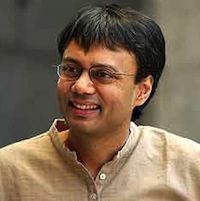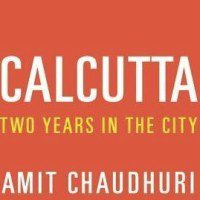In an interview with his biographer, the great Bengali director Satyajit Ray attempted to downplay the concluding shot of Mahanagar (The Big City), which settles on a streetlight overlooking a busy Calcutta boulevard, with one bulb shining and the other in darkness. Ray claimed that this was simply an observation on the state of minor infrastructure in Calcutta, where a number of things in the city are often not working properly. Pressed further, he conceded only that this image speaks to the lyricism of Calcutta, a city he rendered in his work in unprecedented detail and visual complexity.
Anyone who has spent time in Calcutta (and I use its retired name deliberately) understands the pull of dual sentiments there: the routine and almost banal way in which the workings of the city can feel like a series of unworkings—rolling blackouts, unforeseen strikes, power outages—and its simultaneous dwelling in a luminous, seemingly transtemporal imaginary. This was and is a place of writers, Marxists revolutionaries, artists, and radical men and women. They haunt the city’s nooks and crannies—its golis, as the colloquial Bengali term describes them. But what has become of this place that was once the teeming locus of 19th century colonial pride is something of a mystery to anyone who has passed through it recently.
Amit Chaudhuri’s travelogue/memoir, Calcutta: Two Years in the City, does not mourn a lost, genteel past as much as it investigates how this world of anglicized Brahmins and quotidian poets was somehow ushered into the modernity of the city’s current era. Calcutta is now Kolkata. It has sprawling, American-style malls. It has stepped into the arena of what surely represents one of the defining traits of post-1980s globalization: fusion cuisine. Cumulatively, these changes represent the outcome of many urban centers that have suffered the violence of decolonization and now seem to be drifting into a hyper-consumerist present, however uneasily. It is on this drift that Chaudhuri’s book is poised, sometimes for the better, sometimes for the worse. Chaudhuri—who was born in Calcutta but raised in Bombay, and whose parents eventually settled in Calcutta—returns in 1999, conveying his bewilderment at seeing a city morphed by decades of Communist governing and a very belated entry into the capitalist market. His musings, which range from observing the thick of Park Street on Christmas Day to studying the failure of Italian chefs to gain traction, are bracketed by graver events from Calcutta’s recent past: the thrilling, dangerous highs (the Naxalite movement of the late ’60s) and somewhat misunderstood lows (the decline of Left rule in the ’90s in spectacularly petty fashion). And then there is the specter of the Bengali Renaissance (the mid to late 19th century cultural, literary and religious phenomenon that produced such towering figures as Rabindranath Tagore) that hangs over Calcutta’s Victorian manor homes and cafes: in Chaudhuri’s view, a self-created project by which “Bengalis were not only producing the canon—poetry, fiction, criticism—but making their own history.”

Of course it is not simply Bengalis who inhabited Calcutta, and Chaudhuri alludes, though with far less scrutiny, to the communities that have shaped the city: Marwaris, the Chinese, Muslims. But the city’s cultural and religious cosmopolitanism belies the rigidity of its self-consciousness, and “anyone,” writes Chaudhuri, “who has an idea of what Calcutta once was will find that vanished Calcutta the single most insurmountable obstacle to understanding, or sympathizing with, the city today.” This sense of impediment manifests itself in Chaudhuri’s reflections on his own struggle to address the city without the cover of fiction. He notes that while many of his wonderful novels—A Strange and Sublime Address, Freedom Song—take place at least partly in Calcutta, he no longer feels the desire to write about it. At the heart of this writerly ambivalence is the question of how Calcutta has understood itself through a number of significant changes: this is the subject of Calcutta’s third, and perhaps most compelling chapter, “Names.” The book’s title might strike some readers as anachronistic, since the anglicized name “Calcutta” reverted back to the more overtly Bengali Kolkata in 2001. This was, of course, a means to escape the specter of colonial hegemony, as many other cities (Shanghai, Mumbai) have understood. So why give a potentially troubling moniker the place of honor in a memoir? Having lived in Calcutta in the 90s, as the Bengali child of parents who can only be described as a crossbreed of two groups—the “dying-out” bhadralok, or genteel Bengali bourgeoisie, and what Chaudhuri identifies as the dreaded “NRI,” the non-resident Indian—I find that the following observation from Calcutta rings most true to me: “I myself can’t stand calling it any other name but ‘Calcutta’ when speaking in English; just as I’ll always call it ‘Kolkata’ in Bengali conversation…To take away one or the other name is to deprive the city of a dimension that’s coterminous with it, that grew and rose and fell with it, whose meaning, deep in your heart, you know exactly.” This may seem like a bit of cryptic, sentimental fluff. But Chaudhuri’s claim seems to get at the city’s most closely guarded secret: that it has always been modern, at least in its own self-conception, and that its name must always contain the double valence of such an awareness (the past as modern, the present as past).
Modernity, but more specifically, how modernity is measured and refracted by the quotidian, is the overarching concern of Calcutta. In an interesting moment of reflection that takes place at the Jewish Museum in Berlin (in Hallesches Tor), Chaudhuri realizes “that modern man, twentieth-century man—in all his or her unimpressiveness and unintended comedy, in his or her preoccupation with shopping, the arts, the stock market, keeping diaries, borrowing books, going to the cinema, reading newspapers—might be the subject of a memorial, and have these enthusiasms recorded and collections and possessions displayed.” While this is a hardly a new revelation (the juxtaposition of the everyday and the grandiose forms the basis of many Homeric similes from the Illiad, for instance), Chaudhuri draws out of Calcutta, and indeed, the “dwindling” Bengali culture he examines, the extraordinary way in which they both derive their quiet richness from the texture of these day-to-day practices. Modernity, in Chaudhuri’s vision, appears as a constant movement between self and world, and thus Calcutta uniquely embodies, for him, a kind of derelict newness that he begins to spy everywhere, from the works of Eudora Welty to Katherine Mansfield. We discover, finally, the “secret” of Chaudhuri’s meandering vision: in all its imaginative nostalgia and comical minutia, it writes itself, over and over, stubbornly, just like the city the author has come to deeply understand.





One response
Enjoyed reading the review. I reviewed it juxtaposed against the British Council exhibition ‘Homelands’.
http://www.artslant.com/par/articles/show/37994
Click here to subscribe today and leave your comment.